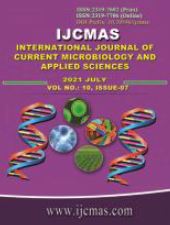


 National Academy of Agricultural Sciences (NAAS)
National Academy of Agricultural Sciences (NAAS)

|
PRINT ISSN : 2319-7692
Online ISSN : 2319-7706 Issues : 12 per year Publisher : Excellent Publishers Email : editorijcmas@gmail.com / submit@ijcmas.com Editor-in-chief: Dr.M.Prakash Index Copernicus ICV 2018: 95.39 NAAS RATING 2020: 5.38 |
The quality of any surface water body is a function of either or both natural influences and human activities going on around the environment. The Azumini Odumaya stream in Obio/Akpor Local Government Area of Rivers State was evaluated for its Microbiological quality. Forty (40) water samples were aseptically collected from five designated Stations along the stream, for a period of four (4) months using sterile bottles and transported to the Microbiology laboratory. Microbiological analyses were carried out using standard microbiological methods. The following culture media were used: Nutrient agar, Eosin methylene blue, MacConkey, Salmonella-Shigella, Thiosulfate-citrate bile salts sucrose agar, Centrimide agar and Sabouraud dextrose agar. Bacterial isolates were characterized using biochemical techniques while the fungal isolates were characterized macroscopically and microscopically. The total heterotrophic bacterial counts, Vibrio counts, Salmonella-Shigella counts, total coliform counts, feacal coliform counts, and Pseudomonas counts of the water samples ranged from: 5.32 × 106 ± 0.63 to 9.21 × 106 ± 6.71, 2.39 × 103 ± 1.8 to 1.15 × 104 ± 1.97, 1.68 × 104 ± 1.84 to 2.88 × 104 ± 1.49, 2.02 × 104 ± 1.48 to 6.4 × 104 ± 1.63, 1.89 × 104 ± 1.56 to 8.9 × 104 ± 1.08, 0 to 3.9 × 102 ± 1.43 and 3.3 × 10 ± 0.83 to 1.11 × 102 ± 1.4 CFU/ml, respectively. The bacterial isolates identified from the various Stations include: Bacillus sp, Staphylococcus sp, Pseudomonas sp, Salmonella sp, Vibrio sp, Klebsiella sp, Enterobacter sp, Providencia sp. and E. coli. The fungal counts ranged from 3.3×10 ± 0.83 to 1.11×102 ± 1.4 CFU/ml. Fungal isolates identified include: Pencillium chrysogenium, Aspergillus niger, Fusarium solani, Mucor sp, Rhizopus sp and Candida albicans. The bacterial populations were very high and the detectable faecal coliform counts were also very high. The presence of E. coli which is an indicator of faecal contamination confirms that the stream is faecally contaminated which is also an indication of possible contamination with pathogenic bacteria. Many of the bacterial isolates are potential pathogens which are associated with gastroenteritis and other forms of bacterial infections. These findings indicate public health hazards if the water is used for domestic purposes without any form of treatment.
 |
 |
 |
 |
 |